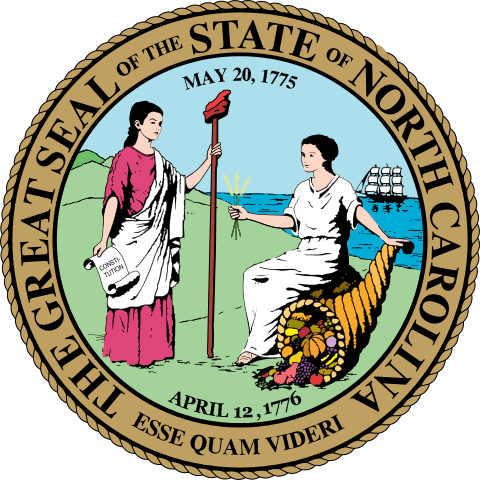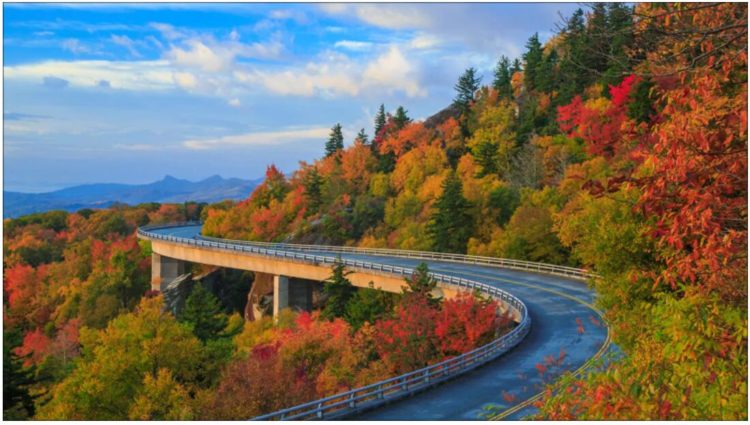North Carolina is on the Atlantic coast situated state in the eastern United States. Raleigh has been the state’s capital since 1792.
North Carolina is nicknamed “The Old North State” and “Tar Heel State” – Old North State or State of Tar Heels, the residents are known as “Tar Heels”. The exact origin of the term is unclear, but most experts suspect that the origins lie in the extraction of tar, pitch and turpentine from the extensive pine forests of the former British colony.
North Carolina is part of the cultural greater region of the southern states, both the regional music, the typical cuisine and the traditional open-air theater are characterized by it, while different influences can be found in the architecture of the state.
In addition to a number of museums, nature and monument protected areas and individual buildings are of supra-regional importance. In addition, the majority of North Carolina’s visitors are drawn to the Great Smoky Mountains National Park, the most visited national park in the United States.
Another attraction are the annual NASCAR automobile races and the college sports competitions held between the universities.
| Area | 139,389 km² |
| Residents | 10,146,788 |
| Residents per km² | 72.8 |
| Capital | Charlotte |
| Postal Code | NC |
| ISO-3166-2 code | US NC |
| FIPS code | 37 |
Geography
North Carolina is bordered by South Carolina and Georgia to the south, Tennessee to the west, and Virginia to the north.
Climate
In most of the state there is a warm, moderate rainy climate ; The higher-lying areas in the Appalachian Mountains, which are included in the zone of the fully humid boreal climate, are excluded. The mountains often serve as a “shield” for the Piedmont region, keeping out low temperatures and storms from the Midwest. The average daily temperature in most areas of the state is around 32 ° C in July. In January the average temperature is 10 ° C.
Because of its exposed location on the Atlantic coast in the extreme southeast, North Carolina is hit by a hurricane on average once a decade with great force, and the state is hit by other tropical storms about every three to four years. In some years, North Carolina may experience multiple hurricanes and other tropical storms, or feel the effects of the extensions of those storms on the coastal plain.
Flora and fauna
The flora and fauna are diverse and range from the shallow-rooted vegetation of the coast and the American alligators that live there to the coniferous forests in the west where bears and white-tailed deer live.
History
The current state goes to a company in 1663 Crown Colony back and is named after the English king I. Karl named. In 1776, North Carolina was one of the 13 colonies that separated from the motherland in the American Declaration of Independence, making it one of the founding states of the United States.
Raleigh has been the capital of the state since 1792 ; the city was named in honor of the discoverer of the North Carolina coast, Sir Walter Raleigh.
During the American Civil War from 1861 to 1865, North Carolina left the United States and joined the Confederate States of America. He was returned to the United States in 1868 in the post-war reconstruction process. Now the transformation from an agricultural state to an industrial region, which lasted until the first half of the 20th century, began.
After the New Deal in the 1930s, North Carolina became a center of American finance and research and development in various high-tech industries.
Economy
North Carolina has been a strongly agricultural state in its history, rice, cotton and tobacco were often grown on plantations. Forestry, which mainly produced tar and turpentine, was also important. As in most southern states, a restructuring towards an industrialized society began only very slowly after the Civil War; One of the main focuses of the economy is agriculture and the processing of agricultural and forestry products.
After losing many manufacturing jobs as a result of globalization, North Carolina has made multiple efforts to attract research and development companies. In addition to the positive development in the financial sector, high-tech companies are now among the most important employers in the former low-wage region.
The real gross domestic product per capita was 51,041 US dollars in 2016. This ranks the state in the middle of the national comparison, 30th out of 50 US states. The national average is $ 57,118.
The unemployment rate was 4.3% in November 2017 (national average: 4.1%).
Black Belt
As a Black Belt (English for Black Belt) different defined areas in are the United States of America called.
Black Belt graphical term
As early as the 19th century, the term Black Belt was used for an area in the sense of physical geography in the states of Mississippi and Alabama, which was given this name due to its fertile dark calcareous soil. This Black Belt is a narrow, long band around 480 km long and 40–50 km wide. It runs from the northern border of the state of Mississippi in a southeast direction to the center of Alabama. The area was one of the main cotton growing areas until the Civil War. In addition to cotton cultivation, cattle breeding and the cultivation of soybeans are currently widespread here.
Black Belt as a sociological term
About the graphical concept beyond Black Belt was later also used in the sociological sense. Here it refers to those regions in the southern states that have a particularly high proportion of African Americans in the total population.
The sociologist Arthur F. Raper defined the term in 1936 as the total of the approximately 200 counties with a share of African Americans over 50%. A study commissioned by the University of Kentucky and published in 1997 by Ronald C. Wimberly and Libby V. Morris defines the Black Belt as a largely contiguous area of 623 counties in the eleven southern states of Alabama, Arkansas, Florida, Georgia, Louisiana, Mississippi, North Carolina, South Carolina, Tennessee, Texas, and Virginia.
These counties are predominantly rural, economically weak and have a proportion of African-Americans that is above the US-wide average.
At the 2000 census, Jefferson County, Mississippi, had the highest percentage of African Americans at 86.5% of any counties.
The Black Belt, as defined by Wimberly and Morris, has the lowest per capita income, the lowest average level of education and the highest unemployment of all regions in the United States.
In the Black Belt are essentially those counties in the southern states, which are politically influenced by the Republican Party, in which the Democratic Party candidate receives a majority in presidential elections.
Also known as Tar Heel State, North Carolina is short for NC with a population of 8,049,313. The capital city of North Carolina is Raleigh and the biggest city is Charlotte.

